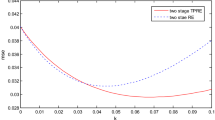Abstract
Once the structure form of demand and supply is translated into areduced form, one can solve the reduced form with a state space modelof the Kalman filter method. This paper discusses an innovationrepresentation that links the structure form with the state space model.For the state space model, the recursive Expectation Maximization(EM) algorithm is used to estimate the parameters of a structure form.This research successfully applied the Kalman filter method to theestimation of the coefficients of simultaneous equations withoveridentifying rank restrictions. The empirical monthly data set camefrom the medium-size scooter market in Taiwan during 1987 to 1992period.
Similar content being viewed by others
References
Aoki, Masanao (1987), State Space Modeling of Time Series, Springer-Verlag, Berlin Heidelberg.
Boas, J. (1989), 'Forecasting under unstable conditions: A case study of the cocoa market', European Journal of Operational Research, 41, 15–22.
Bowman, K.O. and Shenton, L.R. (1975), 'Omnibus Contours for Departures from Normality Based on b1/2 1 and b2', Biometrika, 62, 243–250.
Burmeister, E., Wall, K.D. and Hamilton, J.D. (1986), 'Estimation of unobserved expected monthly inflation using Kalman filtering', Journal of Business & Economic Statistics, 4(2), 147–160.
Dempster, A.P., Laird, N.M. and Rubin, D.B. (1977) 'Maximum likelihood from incomplete data via the EM algorithm'. J.R. Statist. Soc. B 39, 1–38.
Gilbert, P.D. (1995), 'Combining VAR estimation and state space model reduction for simple good predictions.' Journal of Forecasting, 14, 229–250.
Harvey, A.C. (1989). Forecasting, Structural Time Series Models and Kalman Filter, Cambridge University Press.
Mehra, R.K. (1970), 'On the identification of variances and adaptive Kalman filtering,' IEEE Transactions on Automatic Control, AC-19(2), 175–184.
Myeres,K.A. and Tapley,B.D. (1976), 'Adaptive sequential estimationwith unknown noise statistics', IEEE Transactions on Automatic Control, August 520–523.
Shumway, R.H., and Stoffer, D.S. (1982), 'An approach to time series smoothing and forecasting using the EM algorithm', Journal of Time Series Analysis, 3(4).
Yang, C. and Chen, W.D. (1995), 'An application of the state space model by using Kalman filter: the analysis of the demand and supply model of medium-size scooter market in Taiwan', Management Review, 14(2), 41–58.
Author information
Authors and Affiliations
Rights and permissions
About this article
Cite this article
Yang, C., Chen, W.D. Applying Kalman Filter on Solving Simultaneous Equations with Overidentifying Rank Restrictions: The Analysis of the Demand and Supply Model of Medium-size Scooter Market in Taiwan. Economics of Planning 30, 33–49 (1997). https://doi.org/10.1023/A:1002977020341
Issue Date:
DOI: https://doi.org/10.1023/A:1002977020341




